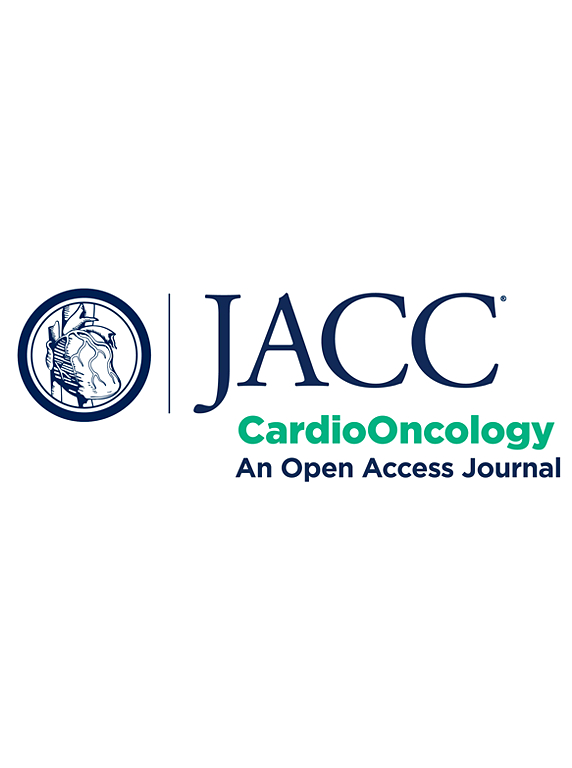Risk Stratification for Trastuzumab-Induced Cardiac Dysfunction and Potential Implications for Surveillance
IF 12.8
1区 医学
Q1 CARDIAC & CARDIOVASCULAR SYSTEMS
引用次数: 0
Abstract
Background
Although patient factors and sequential anthracycline use contribute to risk for cancer therapy–related cardiac dysfunction (CTRCD) with HER2-directed cancer therapy, frequent (every 3 months) left ventricular ejection fraction (LVEF) surveillance is recommended irrespective of baseline risk.
Objectives
The aim of this study was to examine the incidence of trastuzumab-associated CTRCD in a contemporary cohort with HER2-positive breast cancer and assess the performance of a risk assessment tool to identify patients at low risk for CTRCD to guide risk-based surveillance strategies.
Methods
A retrospective cohort of patients with HER2-positive breast cancer treated with trastuzumab at a tertiary cancer center was examined. Patients were categorized as low, medium, and high or very high risk for CTRCD by Heart Failure Association/International Cardio-Oncology Society risk assessment.
Results
Of 496 patients treated with trastuzumab, 29.8% also received anthracyclines. Over a median follow-up period of 51 months, 8.7% developed CTRCD, but only 1.6% had associated heart failure (HF). CTRCD rates were 3.6%, 12.8%, and 32.1% in low-risk, medium-risk, and high or very high risk groups, respectively. HF incidence was 0.4% in the low-risk group and 2.1% in the medium-risk group, with no HF in patients at low- or medium-risk who received trastuzumab without anthracyclines. HF was observed in 11% of high-risk patients. The risk assessment had a negative predictive value for CTRCD in low vs moderate- or high-risk patients of 96.4% (95% CI: 93.5%-98.3%).
Conclusions
The findings support the exploration of a prospective personalized risk-based approach to cardiac LVEF surveillance during trastuzumab therapy. Less frequent LVEF monitoring in low-risk patients may optimize resource use and reduce patient burden without compromising safety.
曲妥珠单抗诱发心功能障碍的风险分层及其监测的潜在意义
背景尽管患者因素和连续使用蒽环类药物会导致HER2导向性癌症治疗中癌症治疗相关心功能不全(CTRCD)的风险,但无论基线风险如何,都建议经常(每3个月)监测左心室射血分数(LVEF)。本研究的目的是检查当代HER2阳性乳腺癌患者队列中曲妥珠单抗相关CTRCD的发生率,并评估风险评估工具的性能,以确定CTRCD低风险患者,指导基于风险的监测策略。结果 在接受曲妥珠单抗治疗的 496 例患者中,29.8% 的患者同时接受了蒽环类药物治疗。在中位 51 个月的随访期间,8.7% 的患者出现了 CTRCD,但只有 1.6% 的患者伴有心力衰竭 (HF)。低风险组、中风险组、高风险组或极高风险组的 CTRCD 发生率分别为 3.6%、12.8% 和 32.1%。低风险组的心房颤动发生率为0.4%,中风险组为2.1%,接受曲妥珠单抗治疗而不使用蒽环类药物的低风险或中风险患者没有发生心房颤动。11%的高危患者出现了心房颤动。风险评估对低危与中危或高危患者 CTRCD 的阴性预测值为 96.4%(95% CI:93.5%-98.3%)。结论:研究结果支持在曲妥珠单抗治疗期间探索一种基于风险的前瞻性个性化心脏 LVEF 监测方法。在低风险患者中减少 LVEF 监测频率可优化资源使用,减轻患者负担,同时又不影响安全性。
本文章由计算机程序翻译,如有差异,请以英文原文为准。
求助全文
约1分钟内获得全文
求助全文
来源期刊

Jacc: Cardiooncology
Multiple-
CiteScore
12.50
自引率
6.30%
发文量
106
期刊介绍:
JACC: CardioOncology is a specialized journal that belongs to the esteemed Journal of the American College of Cardiology (JACC) family. Its purpose is to enhance cardiovascular care for cancer patients by publishing high-quality, innovative scientific research and sharing evidence-based knowledge.
The journal aims to revolutionize the field of cardio-oncology and actively involve and educate professionals in both cardiovascular and oncology fields. It covers a wide range of topics including pre-clinical, translational, and clinical research, as well as best practices in cardio-oncology. Key areas of focus include understanding disease mechanisms, utilizing in vitro and in vivo models, exploring novel and traditional therapeutics (across Phase I-IV trials), studying epidemiology, employing precision medicine, and investigating primary and secondary prevention.
Amyloidosis, cardiovascular risk factors, heart failure, and vascular disease are some examples of the disease states that are of particular interest to the journal. However, it welcomes research on other relevant conditions as well.
 求助内容:
求助内容: 应助结果提醒方式:
应助结果提醒方式:


